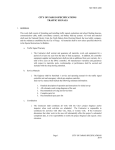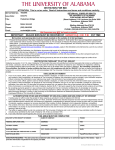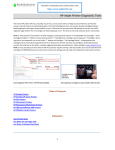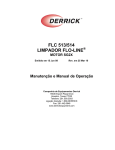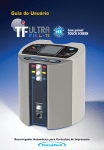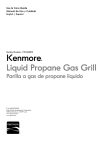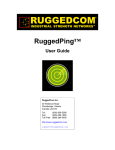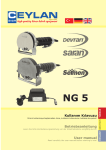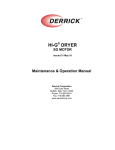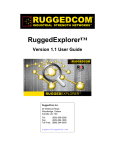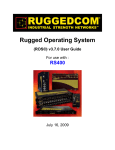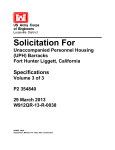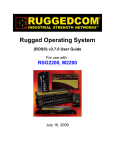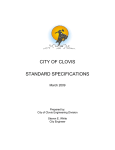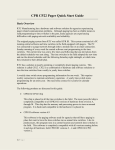Download city of fargo specifications traffic signals
Transcript
SECTION 4200 CITY OF FARGO SPECIFICATIONS TRAFFIC SIGNALS 1. GENERAL This work shall consist of furnishing and installing traffic signals, pedestrian and school flashing beacons, communication cable, traffic surveillance cameras, and battery back-up systems. All work and material shall meet the National Electric Code, the North Dakota State Electrical Board, the local utility company, and the ordinances established by the City of Fargo. All materials shall be new unless specified otherwise in the Special Instructions for Bidders. a. Traffic Signal Warranty i. The Contractor shall warrant and guarantee all materials, work, and equipment for a period of at least one year from the date of final acceptance. In addition, the controller equipment supplier and manufacturer shall provide an additional four-year warranty, for a total of five years on the EPAC controller. All manufacturer warranties and guarantees with respect to materials, parts, workmanship, or performance shall be secured and included with the shop drawing submittal. b. Service Manuals i. The Engineer shall be furnished 1 service and operating manual for the traffic signal controller unit and emergency vehicle pre-emption controller. Each service manual shall include the following minimum information: 1. 2. 3. 4. 5. c. Detailed description of operation and instructions for initial set-up All schematics and wiring diagrams of the unit Recommended servicing and service hints Complete parts list Recommended spare parts list Coordination i. The Contractor shall coordinate all work with the City’s project Engineer and/or inspector when work activities are scheduled. The Contractor is responsible to coordinate his activities with other City, State, or County work. If the Contractor determines that other work in the area will substantially affect the project’s substantial completion date, it is his responsibility to notify the project Engineer and request a time extension. d. Location of Existing Utilities i. Partial existing utilities have been shown to direct the Contractor’s attention to their existence. Such utilities have been plotted from record drawings. Page 1 CITY OF FARGO SPECIFICATIONS 2012 SECTION 4200 ii. The Contractor is cautioned that all existing utilities may not be shown. The location of existing utilities is not guaranteed, and the Contractor will be responsible for determining the exact location and protection of the existing utilities. The Contractor, before commencing any excavation or construction, shall find out the location and seek aid in locating all public and private utilities. The Contractor shall contact ND One-Call 1-800795-0555 and request locates prior to beginning construction. Subcutting or scarifying over utility lines may be eliminated if, in the opinion of the Engineer, a hazardous situation exists. iii. The Contractor is responsible for verifying and following minimum horizontal and vertical clearance between light and/or signal standards and overhead power lines. e. Stop Sign Removal i. Removal of existing stop signs prior to starting up the operation of a traffic signal shall be incidental to installing the traffic signal system. 2. TRAFFIC SIGNAL INITIAL AND FINAL INSPECTION AND SUBSTANTIAL COMPLETION a. The project will not be classified as substantially complete until the signal system is functional, including the completions of all pay items including a fully functional fiber optic communication system. b. After the Contractor has completed the installation of the signal system(s) and any clean up items, he shall complete the “Contractor’s Pre-Initial Traffic Signal Inspection Check List” provided by the City. Each item on the checklist shall be inspected by the Contractor. The Contractor’s personnel that actually did the inspection shall initial each item showing that it has been completed. The completed check list shall be forwarded to the Engineer, along with the request for an initial inspection on the form provided by the City. The Engineer will set a date and time for the initial inspection. At the time of either an initial or final inspection, the Contractor is required to open and close all pull boxes, open and close all signal standard doors, and remove and hold wiring to allow for inspection of anchor bolt nut tightness with hammer test. Contractor shall be present within 10’ of each item being inspected to ensure clarity on what needs to be corrected. c. Initial and final inspections will not be performed between November 1st and April 1st. Inspections will not be done if there is rain or snow or wind greater than 15mph or if the temperature is less than 50° F. d. All items requiring additional work after the initial inspection will be noted by the City on the checklist. The Contractor shall complete work on all items prior to requesting a final inspection. A final functional inspection will be made a minimum of 30 more days after the initial inspection date. The Contractor shall submit, in writing to the Engineer, that all punch list items have been completed and request a final inspection on the form provided by the City. The Engineer or inspector may, at his discretion, stop the final inspection and require the Contractor to resubmit his Page 2 CITY OF FARGO SPECIFICATIONS 2012 SECTION 4200 request for final inspection after completing the required work. The City of Fargo will perform one initial inspection and one final inspection at no cost to the Contractor. Additional initial and final inspections shall assess the prime Contractor a fee of $250 for each time an additional initial or final inspection is performed. The project will not be classified as final until the City accepts the project and assigns a final acceptance date. The date of final acceptance will be 30 days without failure for the City to accept the system. If the system fails during the 30-day acceptance period, the 30 days will start over after the failure has been repaired and inspected by the City. The Contractor is responsible for all maintenance of the signal system until the date of final acceptance, which includes being responsible for the system 24 hours a day, 365 days a year until the final acceptance date is reached. 3. SHOP DRAWINGS a. The Contractor shall provide an electronic PDF file of shop drawings and certifications required by the City of Fargo within 15 days after the contract has been signed by the City Commission. All shop drawings and certifications shall be approved prior to any work being started. The Contractor shall be responsible for the accuracy of the shop drawings. The Engineer’s review does not relieve the Contractor of full responsibility for providing a quality product that meets Specifications. b. The Contractor shall submit shop drawings on the following listed items for approval: i. Traffic Signal Controller Cabinet 1. 8” Cabinet Riser 2. Load Bay 3. Siemens Eagle Controller 4. EDI Conflict Monitor 5. Voltage Surge Suppression 6. Flash Transfer Power Relay 7. Solid State Flasher 8. Solid State Load Switches with Input and Output Indicators 9. Detector Rack 2.4 AMP Power Supply 10. Vehicle Detector Rack Card 11. GTT Model 764 Opticom Phase Selector 12. RuggedCom Switch ii. Battery Backup Cabinet 1. UPS Power Module 2. Batteries 3. Battery Charge Management System 4. Maintenance Bypass Switch 5. Signal Cabinet Circuit Breaker iii. Feed Point Cabinet 1. Surge Protection 2. Circuit Breaker 3. # 6 Power Wire THW & RHW Page 3 CITY OF FARGO SPECIFICATIONS 2012 SECTION 4200 iv. EVP System 1. Opticom Detector 2. EVP Confirmation Light 3. EVP Mounting Hardware 4. Opticom Cable v. Fiber Communication 1. Fiber Optic Cable 2. Fiber Optic Pigtail 3. Fan Out Kit 4. Fiber Optic Connectors 5. Fiber Optic Jumper Cables 6. Fiber Optic Distribution Panel 7. Fiber Optic Splice Cabinet 8. Fiber Optic Tyco Splice Enclosure 9. 4 Port Active Optical Star Coupler vi. Vehicle Heads 1. Housing 2. Back Plate 3. LED Sections 4. Mounting Hardware 5. Visors vii. Pedestrian Heads 1. Housing 2. Visor 3. LED section 4. Mounting Hardware viii. Signal Standards 1. Standard 2. Mast Arm 3. T-Base 4. Anchor Bolts 5. Bolts, Nuts, & Washers 6. Luminaire Extension & Fixture ix. Pull Box 1. Frame 2. Cover x. Pedestrian Push Buttons 1. Button 2. Housing 3. Sign 4. Post xi. Detection Loops 1. Loop Wire 2. Loop Sealant 3. Loop Lead-in 4. Splice Kits Page 4 CITY OF FARGO SPECIFICATIONS 2012 SECTION 4200 xii. Conduit & Innerduct xiii. Signal Control Cables 1. No.14 AWG 12 2. No.14 AWG 7 3. No.14 AWG 5 4. No.14 AWG 3 5. No.14 AWG 2 xiv. Master Controller xv. Labeling Tape xvi. Camera Equipment 1. Camera 2. Mounting Hardware 3. Power Supply 4. Cables 5. RuggedCom Switch xvii. Interim Traffic Signal 1. Wood Service Poles 2. Vehicle Head Hardware 3. Pedestrian Head Hardware 4. Span Wire 5. Guy Wire Anchors & Hardware 6. Junction Boxes on Poles 7. Weather Entrance Heads 8. Span, Sstabilization, & Guy Wire I-Bolts and Hardware 9. 1” Ultratite-Type UL Liquid Tight Flexible Metal Conduit 4. SIGNAL PAINT The traffic signal system components shall be painted in accordance with the following: a. All new signal standards shall be shall be painted with the Millerbernd Factory Finish Paint Coat Specification using the Millerbond I2/ZRU Paint System, with a clear top coat. Colors shall be as follows: i. ii. iii. iv. v. vi. vii. viii. Transformer base – gloss black Mast arm – yellow* or gloss black (see plans) Signal head mounting hardware – yellow* or gloss black (see plans) Shaft – yellow* or gloss black (see plans) Signal housing – yellow* or gloss black (see plans) Pedestrian push-button post – yellow* or gloss black (see plans) Pedestrian push-button housing – yellow* or gloss black (see plans) Signal head doors, back plates and visors – flat black *Yellow color shall be No.13538 of Federal Standard No. 595 B. Page 5 CITY OF FARGO SPECIFICATIONS 2012 SECTION 4200 b. All areas requiring painting or touch up paint shall be prepared as follows: i. If rusted: 1. Completely remove all rust and loose paint. 2. Sand all painted areas with 40 to 100 grit paper, depending on conditions. 3. Wash down with “no rinse prepaint cleaner” manufactured by Great Lakes Laboratories. 4. Prime bare metal with Devran 205 Primer manufactured by Devoe high performance coatings, or an approved equal. 5. Top coat and clear coat with products supplied by the original pole manufacturer. ii. All other non-rust paint areas: c. 1. Remove loose paint. 2. Sand all paint areas with 40-grit paper. 3. Wash down with “no rinse prepaint cleaner”. 4. Prime bare metal with Devran 205 Primer manufactured by Devoe high performance coatings, or an approved equal. 5. Top coat and clear coat with products supplied by the original pole manufacturer. The following method shall be followed for re-painting existing Standards when required on the plan: i. Sandblast Signal Standard 1. Remove all bandit mounting material, signs and pedestrian buttons. 2. Completely remove all rust and paint by White Metal Blasting the signal standard. 3. White Metal Blast cleaning is used when a totally cleaned surface is required. This method of cleaning is defined as a sandblasted cleaned surface with a graywhite uniform metallic color. It shall be free of all oil, grease, dirt, mill scale, rust, corrosion products, oxides, paint, stains, streaks or any other contaminant across 100% of every square inch. Page 6 CITY OF FARGO SPECIFICATIONS 2012 SECTION 4200 4. Sandblasting material shall be a steel grit angular carbon steel. 5. Sandblasting shall be done on site with the signal standards in place and operational. All pedestrians and the traveling public shall be protected from all debris. All sandblasting material and removed pole paint/debris shall be collected in a method that is approved by the EPA. Existing pole paint-debris may contain harmful chemicals or existing lead paint, which the Contractor shall be responsible for containing and cleaning up, along with protecting pedestrians and the traveling public from these hazardous contaminates. 6. Before the primer is applied the pole must be inspected by the City of Fargo to ensure that it is free of all paint, rust and contaminates. Pole must be prepped according to Specifications and to the satisfaction of the Engineer in the field. Pole may need to be re-blasted or may need to be cleaned with Devoe DEVPREP 88 cleaner. The Engineer in the field will require which method shall be used. ii. Paint Signal Standard 1. Mask all areas as per detail sheet in plans. 2. Prime bare metal with Devoe Devran 205 Primer. 3. Apply two top coats of Devthane 379UVA manufactured by Devoe high performance coatings, and one coat of clear coat as recommended by the top coat manufacturer. *Yellow color shall be No.13538 of Federal Standard No. 595 B. 4. Thickness of all coats applied shall be according to the manufacturer’s recommended film thickness. Application of all materials shall follow the manufacturer’s directions for use. 5. Re-install all pedestrian push buttons and signs. Re-install iron pole plates for vehicle heads as per detail. Remove all masking. iii. The Contractor shall warrant and guarantee all materials, work, and equipment for a period of at least five years from the date of final acceptance. Contractor is required to get a certified warranty from Devoe to the City of Fargo covering all labor and materials if the paint fails. Cost of warranty shall be included with the price bid for “Paint Signal Standard”. Page 7 CITY OF FARGO SPECIFICATIONS 2012 SECTION 4200 5. PULL BOXES a. Install PVC Box (Detail 5.4) i. Pull boxes shall be PVC with metal frames and covers, and shall conform to the detail included in the plans. ii. Pull boxes in landscaped areas shall have the top of the box 0” to 1” above final grade and sloped to match the slope of the final grade on all 4 quadrants. Pull boxes in concrete area shall be set with the top of the box flush with the final grade at all 4 quadrants. b. Install Fiber Pull Box (Detail 5.10) i. This shall include the cost to supply and install a Quazite pull box. The size shall be 30” x 48” x 48” deep, with no base. The cover will be 1-3/4” thick, secured with stainless steel bolts, and have a logo of “Traffic Signals”. The base and cover shall be made from Quazite and sustain a minimum test load of 12,000#. Color shall be gray. Pull box shall be a PD style enclosure that has a 1 degree flare to prevent frost heave. ii. Two feet of crushed rock shall be installed for drainage below the pull box and will extend 6” beyond the outside edge of pull box. The top of box shall be at final grade and sloped to match. A 6’ x 6’ concrete pad shall be installed around the IT-Pull box. The concrete pad shall be 6” thick, reinforced with 6” x 6” x 10 GA welded wire fabric and shall be incidental to the price bid for IT-Pull Box. 6. PEDESTRIAN PUSH BUTTON AND SIGNS (Detail5.3) a. Pedestrian push button signs shall be bolted directly to the traffic signal standards. Do not use bandit for this purpose. Furnishing and installing pedestrian push buttons and sign shall be included with the price bid for TYPE IV, TYPE V, combo signal standard and pedestrian push button post and interim signal. b. Pedestrian push buttons shall be a Polara Rees Style Bulldog Button with momentary L.E.D. Model #RBDLM2-B-2H (Black) or Model #RBDLM2-Y-2H (Yellow). Pedestrian push buttons shall have a Pelco SE-2000 Rectangular Series box pole mount #SE-0295-P02 (Black) or #SE0295-P01 (Yellow) and flat mount #SE-0294-P02 (Black) or #SE-0294-P01 (Yellow). c. The pedestrian push button post steel post shall meet AASHTO 270 Grade 36. The post shall be provided with a means to attach the pedestrian push button and sign, and it shall have a post cap. The assembly shall be weatherproof. It shall be constructed so an electrical shock cannot be received under any weather condition Page 8 CITY OF FARGO SPECIFICATIONS 2012 SECTION 4200 7. FARGO TYPE B CABINET (Detail 5.3) a. The Cabinet size shall conform to the details shown in the plan and the following: i. Type A Cabinet shall be size M (height 51”, width 36”, depth 17”) ii. Type B Cabinet shall be size P-44 (56” x 44” x 25.5”) b. Anchor bolts must be set into controller foundation when poured. c. When installing the cabinet on the concrete foundation, a bead of high quality silicone caulk shall be placed under the bottom flange of the cabinet within one inch of the outside edge of the cabinet. An additional bead of high quality silver silicone caulk shall be placed continuously around the outside of the cabinet at the seam between the cabinet and the foundation. All exposed outer cabinet seams shall be sealed with a bead of high quality silver silicone caulk. d. The Contractor shall supply a fully wired and terminated NEMA cabinet from the pre-approved supplier list below. The controllers shall be supplied by the same manufacturer and be of the same model number and most recent software. e. City of Fargo Type B Cabinet Assembly with a MARC System, EPAC 3808 Model M-52 Series Controller with Fiber Optic Communications manufactured by Siemens, supplied by Brown Traffic Control, Davenport, IA. The conflict monitor shall be an EDI SSM 12LEip. All cabinets shall be wired for use of either 2 Channel or 4 Channel Global Traffic Technologies Opticom cards. The Contractor shall supply LM 602 Series rack mounted vehicle loop monitors from EDI of Phoenix, AZ. See plans for additional cabinet requirements. f. All new Fargo Type B cabinets shall have a RUGGEDCOM RuggedSwitch RS900-HI-N-T2T2T2 installed in the cabinet. g. Cabinet Wiring Diagram i. The following items shall be labeled on the Cabinet Wiring Diagram: ii. The Loop Designation number (i.e. D2-1) from the plan shall be labeled on the Detector panel drawing adjacent to the point for termination. iii. The field wire terminals for the Vehicle/Pedestrian Head Control Cables shall be labeled with the phase number and direction (i.e. 2, SB). iv. The field wire terminals for the opticom cable shall be labeled with the pre-empt number (i.e. P.E. #1). v. The field wire terminals for the pre-empt indicator lamps shall be labeled with the preempt number and direction (i.e. P.E. #1, N.B.). Page 9 CITY OF FARGO SPECIFICATIONS 2012 SECTION 4200 vi. The field wire terminals for the pedestrian push button cables shall be labeled with the phase number (i.e. 8 PED). vii. Provide an AutoCAD drawing file of the as-built cabinet wiring diagram. viii. All text on the cabinet wiring diagram shall use the Arial style font. ix. The detector rack label shall look like the detector rack label on the plans. The text size shall be .13 in height for all text on the label except the VD1, SD1, VD2, SD2, etc. shall be .09 in height. x. Contractor is responsible for pickup of cabinet prints and for returning one revised print to the cabinet in the field and returning all other copies to the Sign and Signal shop, located at 510 5 St N. 8. h. A complete cabinet conflict monitor test shall be performed and passed by the Contractor just prior to the uncovering of the traffic heads. The City will supply the conflict monitor maintenance record test form. The instructions on this form must be followed completely before the signals are used. Contractor is responsible to provide a flagger traffic control person for the intersection while the conflict monitor test is performed. i. The Contractor shall provide two spare load switches and one spare two-channel vehicle detector for each controller and cabinet supplied on the project. j. All load switches provided as part of this project shall be equipped with both input and output L.E.D.’s. k. Controller working slab shall be 6 feet wide and extend a minimum of 4 feet from the face of the controller foundation. The slab shall be 4 inches thick and reinforced with 6” x 6” x 10 GA welded wire fabric and shall be tied to the controller foundation with 18-inch long #3 rebar spaced 18 inches on center. The controller working slab shall have a slope of .25 inches per foot away from the controller cabinet foundation. The closest point of the top of the slab to finished grade shall be 2 inches above grade, except where matched to sidewalk grade. Working slab shall be incidental to pouring the controller cabinet foundation. VEHICLE AND PEDESTRIAN HEADS (Detail 5.2) a. All signal plumbizer and pedestal adapters/collars shall be steel – absolutely no aluminum. b. All vehicle heads and all pedestrian heads shall be SIG polycarbonate. All heads shall be installed level on all sides. Five section mast arm mounted heads shall be installed using an Astro bracket. All vehicle and pedestrian heads shall be manufactured by Siemens Eagle. All signal heads shall be required to have the A-700882 reinforcement plate kit installed on them. Page 10 CITY OF FARGO SPECIFICATIONS 2012 SECTION 4200 9. c. Astro brackets are approved for use on mast arm mounted 5-section heads. Astro brackets may also be used to mount new heads on existing mast arms that do not have an existing tendon on the mast arm. Shop drawings for signal heads shall indicate the type of mounting. d. Vehicle Indication Alignment of Post and Pedestal Vehicle heads mounted on signal standards shall be leveled on all 4-sides and aimed to the center of the oncoming traffic lane 200 feet from the stop bar. Left turn heads that are post and pedestal mounted shall be aimed to the center of the left turn lane 100 feet from the stop bar. Mast arm heads shall be parallel to oncoming traffic. e. All traffic signal back plates shall be louvered aluminum and have a minimum thickness of .063”. Back plates shall be installed using 3/4” O.D. x 3/16” I.D. x standard thickness washers on all screws. Washers shall be stainless steel #10 fender washers. Screws used to attach the back plates to the signal head shall be ½” #10 pan head tap screws supplied by Northern State Supply #TNP4714-PZ or approved equal. f. All red, yellow and green indications and pedestrian heads shall be L.E.D. signal heads manufactured by Dialight, GEL core or approved equal, conforming to the latest standards of the Institute of Transportation Engineers. Approved 12” L.E.D. balls are Dialight “XL” series red ball part number 433-1210-003XL, yellow ball part number 433-3230-901XL, and green ball part number 433-2270-001XL. GEL core “GTx” series, red ball model number DR6-RTFB-77A, yellow ball model number DR6-YTFB-77A, and green ball model number DR6-GCFB-77A. Approved 12” L.E.D. arrows are Dialight red arrow part number 432-1314-001XOD, yellow arrow part number 431-3334-901XOD, and green arrow part number 432-2374-001XOD. GEL core “GT1” series, red arrow model number DR6-RTAAN-17A, yellow arrow model number DR6-YTAAN-17A-YX, and green arrow model number DR6-GCAAN-17A. Approved pedestrian heads shall be 16”x18” countdown pedestrian signals. Approved pedestrian countdown signals are Dialight part number 430-6479-001X or GEL core model number PS7-CFC1-26A. g. Installing L.E.D. vehicle signal sections shall include furnishing and installing 12 inch L.E.D. vehicle signals existing signal head housing for the existing red, yellow, and green vehicle indications. The price bid shall include all materials and labor for each L.E.D. vehicle signal installed. h. Installing L.E.D. pedestrian signal sections shall include furnishing and installing 16” L.E.D. countdown pedestrian signals manufactured by Dialight, GEL core, or approved equal, into the existing pedestrian signal head housing. The price bid shall include all materials and labor for each L.E.D. pedestrian signal installed. VEHICLE DETECTION LOOPS (Detail 5.4) a. Sawed Vehicle loops shall be shown on the plans and the Loop Detector Detail Sheet. The loop location shall be marked on the pavement. The loop shall be placed in the lane for which it was intended, perpendicular to the lane, and to the size shown in the Contract. The Engineer may move the loop location longitudinally to avoid joints, pavement cracks, manholes, and other Page 11 CITY OF FARGO SPECIFICATIONS 2012 SECTION 4200 obstructions. All vehicle loops in milled areas shall be sawed after the surface has been milled and prior to the final lift of new asphalt. b. Interruption of the normal flow of traffic shall be the minimum time necessary for installation of the road loop. Work shall not begin until all material, equipment, and personnel are at the site. Type III Barricades, warning signs, and flag persons shall be placed to protect the workers and the traveling public. c. Conduit shall be installed from the pull box to the gutter or roadway edge as specified. Each loop shall have a separate conduit installed for the pull box entry. The excavation from the saw slot at the gutter or roadway edge shall be made by means of a punch or drill type tool, rather than by usual excavating methods. The visible portion of the gutter shall not be cut for conduit installation. The conduit shall be installed to directly receive the loop wire in line and not at an angle. The hole to receive the conduit shall be at a depth below the roadway surface so there is a minimum of 2 inches of cover on top of the conduit when installed. Duct Seal shall be inserted into the loop pipe to prevent any sealant from entering the pipe and the top 2 inches of the cover over the conduit hole shall be sealed with the same sealant used to close the saw cut. The conduit and the pull box shall be installed at the same time. d. Only vehicle loop duct type wire shall be used having a ¼-inch XLPE high density polyethylene tube jacket covering a #14 AWG stranded copper conductor with Type XHHW insulation. i. All sawed or preformed loops shall have 3 turns of loop wire. e. Loop Saw Lot i. The pavement slot shall be sawed with a self-propelled power saw equipped with a depth gauge and alignment guide. The pavement slot shall be cut cleanly and well defined. The saw cut shall be overlapped at all corners and right angle corners shall be cored as shown on the Standard Drawings. The saw cut may be made at any time before installation of the wire. Slots shall be cleaned immediately after the cutting operation. ii. All saw cuts shall be sealed with an approved hot pour sealant. Before sealing the saw slot, each saw slot shall be thoroughly cleaned of all dust, dirt, concrete scale, and other foreign matter and blown out with a jet of compressed air. The joint faces shall be clean and dry when the joints are sealed. Joints shall not be sealed when the air temperature is below 40 degrees F. iii. Failure of the saw slot material in either adhesion or cohesion in the first year after the final acceptance date shall be cause for rejection and shall be repaired at the Contractor’s expense. f. Hot Pour Sealant i. The heating kettle shall be of the indirect heating, double-boiler type, using oil or other suitable material as the heat transfer medium. The kettle shall have a thermostatically Page 12 CITY OF FARGO SPECIFICATIONS 2012 SECTION 4200 controlled heat source, accurate temperature indicating devices and an effective mechanical agitator. ii. The sealant shall have a pressure-type applicator and shall completely fill the saw slot from the bottom up to the top, until it is level with the road surface, with no more than ¼” overflow or spillage of sealant onto the pavement surface. Tar buckets will no longer be allowed for application of sealant. g. Loop Lead-In Cables i. Loop lead-in cables shall be a #14 AWG stranded polyethylene insulated twisted pair with a foil shield with drain wire and a polyethylene jacket. The loop lead-in conductor shall not be spliced except at the pull box where this conductor and the loop conductor are spliced together. ii. Loop lead-in conductors shall be lightly sanded, cleaned with an approved method, and wiped clean with a clean towel, then wire nut or crimp connected, then encapsulated in an epoxy splice kit manufactured by URASEAL Product No. CK200B. Conductors in the splice kit shall not be taped together. Loop lead-in and loop wires shall have sufficient slack to extend a minimum of 6 feet above the pull box opening and installed in the pull box with the splice kit taped to a length of 1” PVC such that the splice is secured in the upper 1/3 of pull box h. Testing i. Before pouring the sealer, the loop shall be checked for continuity, inductance, and insulation resistance. The test shall be made in the Engineer’s presence, and the necessary equipment needed to perform these tests shall be furnished by the Contractor. The City reserves the right to retest, and these test results shall govern the acceptance or rejection of the loop installation. Tests shall be made as follows: 1. Continuity Test. Each loop detector circuit shall be tested for continuity at two locations: i. Loop detector at the pull box before splicing with the loop detector lead-in cable shall have a value less than 0.5 ohms. ii. Loop detector and lead-in cable system at the traffic signal controller cabinet or detector cabinet after splicing in the pull box shall have a value less than 5 ohms. The continuity test ohm reading at the traffic signal controller cabinet or detector cabinet shall be greater than the ohm reading measured at the loop detector at the pull box 2. Inductance Test. Each loop detector and lead-in cable system shall have an inductance test measured at the traffic signal controller cabinet or detector cabinet. The inductance shall be in the range of 50 to 700 micro henries. Page 13 CITY OF FARGO SPECIFICATIONS 2012 SECTION 4200 3. Insulation Resistance Test. An insulation resistance test at 500 volts direct current shall be made at the traffic signal controller cabinet or at the detector cabinet between one loop detector lead-in conductor and the cabinet ground rod. The insulation resistance shall have a value of 500 mega ohms or greater. ii. A vehicle loop detector test shall be performed and recorded before the initial inspection using a City provided form. This form will be used for rechecking the loops at the final inspection. iii. The City will retest all loops at the Final Inspection. 10. CONTROL CABLES a. The jacket on all control cables shall be polyethylene with the thickness meeting Table 7.4.2 NEMA WC-70. b. All cables shall be un-spliced, including pedestrian push button wires. c. Terminal boards and blocks shall be provided for connections of control circuits in signal standard bases. d. There shall be no splices below grade except for loop lead-in conductors. Pulled through conductors shall have sufficient slack to extend a minimum of 18 inches above the pull box opening. e. Additional Cable Quantities Additional cable quantities shall be installed to provide for slack and the wiring of controllers, feed points, and signal heads as follows: A. B. C. D. E. F. G. H. Ten feet at the controller Seventeen feet at post-mounted and pedestal-mounted vehicular signal heads Fifteen feet at post-mounted and pedestal-mounted pedestrian signal heads Eight feet at each pedestrian push button Fifteen feet at each flashing beacon sign support Twenty-three feet at each signal pole with mast arm plus the length of the mast arm Ten feet at the feed point Five feet at each foundation for each incoming and outgoing pedestrian and signal head control circuit I. Ten feet at pull boxes where connections are made. J. Ten feet for loop lead-in cables where they are spliced to the loop in the pull box K. Three feet at each foundation for each incoming and outgoing circuit which passes through the foundation with no connection being made. Page 14 CITY OF FARGO SPECIFICATIONS 2012 SECTION 4200 11. EMERGENCY VEHICLE PRE-EMPTION (Detail 5.5) a. All locations on the plans calling for an Emergency Vehicle Pre-emption Detector shall consist of a Global Traffic Technologies Model 722 EVP detector and light assembly. Install assembly 6 feet from end on existing mast arm poles unless otherwise shown on the mast arm detail sheet. Each detector tube shall be aimed at a point 1800’ from the intersection towards the associated oncoming traffic. The indicator lamp shall be angled downward 1 notch from level and aimed at a point 1800 feet from the intersection. b. The Opticom Priority Control System shall be an Opticom Model 764 Multimode Phase Selector. c. Install EVP L.E.D. indicator lamps for all phases when new cabinet/EVP system is in place and operational. d. The Contractor shall notify the Fargo Fire Department when EVP is taken out of service and returned to service. e. The Contractor shall setup and verify the EVP detector operation within one week of the signal being operational to traffic. Contractor shall test range with a Contractor supplied EVP emitter at a distance of 1800’ from the intersection. City will set the EVP range at the initial inspection. f. The EVP system shall be wired with an approved opticom cable that is recommended by the Manufacturer for the EVP detector. i. Top Tube Pre-emption 1 & 3 Blue Wire ii. Bottom Tube Pre-emption 2 & 4 Yellow Wire g. The Contractor shall follow Global Traffic Technologies instructions for all opticom cable connections. If only one circuit is needed, wire both tubes as assigned above. Cap the unused preempt opticom cable wire in the controller cabinet. Aim both tubes in the one direction that is being used. 12. CONDUIT a. Nonmetallic conduit shall be either polyvinyl chloride (heavy wall – PVC) or high-density polyethylene (HDPE) conduit, both as specified below. b. PVC conduit shall meet the requirements of UL 651 suitable for direct burial applications and shall have a minimum wall thickness equivalent to Schedule 40 as defined by ASTM 1785. c. HDPE conduit shall meet the requirements of UL 651 and either ASTM 2447 or ASTM 3035 suitable for direct burial applications. HDPE conduit shall have a minimum wall thickness equivalent to Schedule 40 as defined by ASTM 2447 or DR 15.5 as defined by ASTM 3035. HDPE conduit shall not be installed when either the conduit temperature or ambient temperature is below –10 F. Page 15 CITY OF FARGO SPECIFICATIONS 2012 SECTION 4200 d. Conduit shall be installed at the location shown on the plans. Conduit shall be bored under existing pavement. Boring conduit shall be considered incidental to the bid price for conduit and for which no additional compensation shall be made. e. All conduits shall have bell ends installed on both ends of the conduit run. f. All conduits containing conductor/cables shall be sealed with duct seal at the controller cabinet and at the traffic signal standard foundations. g. All spare conduits shall be plugged with an expanding rubber pipe plug and labeled at the cabinet and signal standard bases. h. The Contractor shall use 2” innerduct for the interconnect conduit. Innerduct shall be 2”, schedule 40 innerduct, smooth outside, controlled outside diameter at 2.375. Inside diameter of 2.027, minimum wall thickness of 0.154, and color ORANGE. Installation of innerduct shall be at a depth of 24” below finished grade. Innerduct will be measured by the linear foot. Couplings/fittings used at concrete bases, and the method of innerduct installation, will not be measured for payment but will be included in the price bid for conduit. Innerduct may also be used for all wire signal conduit runs, but if it is used, it must be red in color. All innerduct shall have Bell Ends installed on both ends of the innerduct run. i. The Contractor shall install two additional 2-inch diameter conduits in each new controller foundation. The direction of these conduits will be determined in the field by the Engineer and labeled in the cabinet by the Contractor. Each foundation for a traffic signal standard and each feed point foundation shall have one spare 2-inch conduit. The direction will be determined by the Engineer in the field and labeled at the foundation by the Contractor. The conduits shall be plugged with a 2” expandable pipe plug. Not a separate pay item, cost is to be included in the price bid for “Concrete Foundation Traffic Signal”. 13. LABEL ALL FIELD CABLES a. All labeling materials shall be approved by the City. Labels shall be readable without moving the cables. All field cables installed by the Contractor shall be labeled with the cable designations: TYPE Communication cable Pedestrian push button Loop lead-in LABEL LOCATION LABEL Comm./intersection address of other end Phase/location (i.e. 2-NW, 2-SW, 2-S MED, etc.) Detection zone (i.e. D2-1, D2-2, etc.) Within 12” of conduit Within 6” of terminals Within 6” of terminals Control cable Cable number & location (i.e. Cable 1-NW, Cable 2SW, etc.) Within 12” of conduit Opticom cable Pre-empt number/location (i.e. P.E. 1-NW, P.E. 2SW, etc.) Within 6” of terminal Page 16 CITY OF FARGO SPECIFICATIONS 2012 SECTION 4200 Camera power cable Camera no./location (i.e. camera 1/NW) Within 6” of terminal CAT 5 cable Camera no./location (i.e. camera 1/NW) Within 6” of terminal b. All labels shall be machine printed on a tape width of 3/4”. All lettering shall be minimum 3/8” uppercase block style letters. The tape shall be affixed around the perimeter of cable with the tail at 90° to the cable. All lettering shall be on the tail of the label and readable without moving the cables. The labeling tape shall be designed for outdoor use. The tape shall have a minimum outdoor durability rating of 5 years in temperature ranging from 180°F to -40°F. The labels shall be capable of being applied outdoors at temperatures as low as 0°F. 14. COMMUNICATION CABLE (Detail 5.10) The communication cable shall be a 24 strand fiber multi-mode/60 strand single mode hybrid optic cable suitable for outside plant operations manufactured by Superior Essex. The cable shall be a loose tube, single jacket, all dielectric cable design. The buffer tubes shall be gel filled, and the cable shall have a dielectric central strength member and a dry water blocking system. Tube colors shall be multi-mode blue tube fibers 1-12, multi-mode orange tube fibers 13-24, single-mode green tube fibers 25-36, single-mode brown tube fibers 37-48, single-mode slate tube fibers 49-60, single-mode white tube fibers 61-72, and single-mode red tube fibers 73-84. FIBER OPTIC CABLE REQUIREMENTS a. Requirement Multi-mode Single Mode Outer Jacket Polyethylene Polyethylene Core Diameter (µm) 62.5 8.0 – 10.0 Clad Diameter (µm) 125 125 Max. Attenuation db ( /km) Min. Bandwidth (MHZ/km) Max. Tensile Loading (N) 3.5 @850 nm 1.0 @1300 nm 160 @850 nm 500 @1300 nm 2700 Short Term 600 Long Term 0.35 @1310 nm 0.25 @1550 nm N/A N/A 2700 Short Term 600 Long Term Fiber Optic Cable i. The fiber optic cable shall be dual window single-mode fiber with a maximum attenuation of 0.4 db/km at 1310 wavelength and maximum attenuation of 0.3 db/km at 1550 wavelength and shall meet or exceed Ethernet transmission standard IEEE 802.3ae. ii. Fiber cable construction shall be loose tube gel-filled color-coding per TIA/EIA 598B standards. The Central Strength member shall contain no metallic conductors. The overall strength member shall be aramid fiber yarn or fiberglass; the inner jacket shall be Page 17 CITY OF FARGO SPECIFICATIONS 2012 SECTION 4200 black UV and moisture resistant PE. The outer jacket will be black UV and moisture resistant PE with sequential meter markings. iii. The item “Communication Cable” will be measured by the linear foot. The quantities measured will be paid for at the contract price and shall be full compensation for all labor, equipment, and material necessary to complete the installation of the communication cable. iv. Fiber optic cable insulation shall have a maximum tensile load of 600 lbs. for installation and 200 lbs. for in-service load. The minimum bend radius shall be 20XOD for installation and 10XOD for in-service. b. Handling of Cable i. Cables or inner duct shall be carefully inspected by the Contractor during placement operation to be certain that the fiber optic cable and inner duct are free from damage before placement. ii. Bends of small radii and twists that might damage cable or wire shall be avoided. During the placement operation, fiber optic cable shall not be bent in a radius less than 20 times the outside diameter of the cable. iii. Care is to be exercised during the placing operation, to feed the cable into the inner duct loosely and at no tension. Equipment and construction methods shall be such as to assure compliance with this requirement. The Contractor shall furnish competent supervision at all times at the site of cable placing operations to assure compliance with this requirement. iv. Every instance of damaged cable or wire observed at any time whether prior to installation, occurring during construction, or discovered by test of observation subsequent to installation in plant, shall be immediately called to the attention of the Engineer. The method of repair or correction of such damage shall be in accordance with the written instructions of the Engineer. The Contractor shall promptly repair such damage or make such corrections in accordance with such written instruction of the Engineer. Minor damage to the outer jacket of the cable or wire observed prior to or occurring during construction shall be repaired in accordance with RUS Splicing Standard Bulletin 1753F-401 (PC-2). v. The Contractor shall use a break-away swivel rated for 600 lb. break load for pulling all fiber optic cables. c. Miscellaneous Specifications i. The Contractor shall include a No. 14 AWG 1 unspliced insulated copper conductor running the full length and parallel to each communication cable installed in conduits as a trace wire. This is not a separate bid item. The cost shall be included in the price bid for Page 18 CITY OF FARGO SPECIFICATIONS 2012 SECTION 4200 communication cable. The trace wire shall be labeled with the intersection address that it connects to. If the distance is too long to have a trace wire un-spliced then the Contractor may splice the trace wire with an epoxy splice kit or a splice method that is approved by the Engineer in the field. ii. The Contractor shall provide 30’ of slack cable in each pull box and 150’ slack for each cable at the cabinet pull box where termination or splicing will occur or 85’ of slack if the fiber cable is completely cut and is the end of the fiber run. The Contractor shall remove 10’ of each cable end that was used to pull cable prior to installing the required amount of slack to be left in the pull box. Contractor is required to contact the Engineer in the field to discuss all footages left in pull boxes and what is needed for splicing before pulling in fiber and cutting it. d. Fiber Optic Terminations And Equipment The price bid for Fiber Optic Terminations and Equipment shall include all necessary connectors, terminations, equipment, labor and all other miscellaneous material to install a fully functional communication system including, but not limited to, the following: i. Supply and install a MM and/or SM fiber optic pigtail that is suitable for outside plant operations manufactured by Superior Essex with a polyethylene jacket. Pigtail shall have a 14” break out length fan out kit with ST connectors that are connected to a fiber distribution panel. ii. All installed ST connectors and fusion splicing. iii. Supplying and installing all fiber optic distribution panels as per plan sheet. 1. Distribution panel labels shall be labeled with the intersection address of the cable’s other end, the port group as shown on the detail, and the number of the fiber strand terminated, and placed on the face of the distribution panel adjacent to the cable’s six fiber ports iv. Providing and installing all fiber optic jumpers. 1. Fiber optic jumpers attached to the distribution panel should be labeled with the fiber # it’s connected to for each port group, representing the port it’s plugged into. Fiber jumpers attached to the EPAC and MARC controllers shall be labeled 1 through 4, representing the port it’s plugged into, starting with a “1” for the port at the top. v. Providing and installing TYCO FOSC 450 B6 or D6 enclosures and splice trays as per plan sheet. vi. Providing and installing any international fiber systems four port active optical star coupler part #DT4010 as per plan. Page 19 CITY OF FARGO SPECIFICATIONS 2012 SECTION 4200 vii. Labeling all fiber cables, fiber tubes, trace wires, fiber pigtails, fiber distribution panels, fiber scalability centers, fibers jumpers, and all individual terminated fibers. e. Fiber Optic Cable Testing i. The City of Fargo will hire an independent Contractor to test all terminated fibers at both ends with an OTDR tester and light meter recording the results on a City of Fargo Fiber Test Report Form and providing a computer printout from the OTDR of each fiber tested. If multi-mode fiber tests at 850 NM and 1300 NM are not within the City of Fargo standards of .5 dB loss for each ST connector at the bulkhead, .2 dB loss for each fusion splice, and .1 dB loss per 100 feet for 850 NM and .1 dB loss per 300 feet for 1300 NM of fiber being tested, then the Contractor shall repair/replace and the Contractor shall retest the fiber with City personnel present. If single-mode fiber tests at 1310 NM and 1550 NM are not within the City of Fargo standards of .5 dB loss for each ST connector at the bulkhead, .2 dB loss for each fusion splice, .1 dB loss per 600 feet for 1310 NM and .1 dB loss per 750 feet for 1550 NM of fiber being tested, then the Contractor shall repair/replace and the Contractor shall re-test the fiber with City personnel present. All fiber shall be tested at each end. Any terminated fiber run that doesn’t meet the testing tolerances specified shall be repaired/replaced by the Contractor. If any connectors or fusion splices fail the Contractor shall repair the connection, if a fiber cable is damaged or broke between connections the Contractor shall replace the entire cable between connections. ii. The City of Fargo will hire an independent Contractor of our choice to test the entire completed fiber optic communication system. The City of Fargo will pay the cost to have the fiber optic communication system tested and will provide the Contractor with the completed test forms. iii. Single mode fiber when tested shall be allowed the following tolerances: .1 dB per 600’ (1310nm), .1 dB per 750’ (1550nm) of fiber, .2 dB for each fusion splice, .5 dB for each ST connector, and .5 dB for each end that is bare fiber tested. iv. Multi-mode fiber when tested shall be allowed the following tolerances: .1 dB per 100’ (850nm), .1 dB per 300’ (1300nm) of fiber, .2 dB for each fusion splice, .5 dB for each ST connector, and .5 dB for each end that is bare fiber tested. v. All fiber optic cable that is removed shall be tested by the Contractor and documented after it is removed and placed on a wire spool. All existing fiber optic cable will be considered good and meeting City of Fargo tolerance Specifications. If the existing fiber tested doesn’t fall within the tolerance of the specification, then the Contractor shall replace the fiber optic cable with a new one. The Contractor may test the existing cable before it is removed with an OTDR or light meter and provide a computer print out of the testing results to the City of Fargo, to ensure that the existing cable is good and meets specification tolerances. Page 20 CITY OF FARGO SPECIFICATIONS 2012 SECTION 4200 f. When all terminations are complete, the City of Fargo must inspect all splices inside the TYCO FOSC enclosures before the fiber optic communication system can be put into use. Contractor must set up a time to have the cases inspected, Contractor must open splice cases and show all splices and fiber tubes inside the TYCO splice case to the Engineer in the field. All fiber tubes shall be labeled inside the splice enclosure. 15. REMOVAL OF TRAFFIC SIGNAL EQUIPMENT a. Remove and Salvage Traffic Signal Equipment i. This item includes the removal and salvage of all above ground and removal and disposal of all unused below ground conduit and pull boxes. All salvaged material shall be delivered by the Contractor to a City storage facility as directed by the Engineer. All salvage material shall be protected by the Contractor, and materials that are damaged by the Contractor’s removal process or mishandling, shall be replaced with new equipment at the Contractor’s expense. Before removing existing equipment, arrangements shall be made for the local utility company to disconnect the power source. When the meter is no longer needed, the local utility will remove it. The Contractor shall disconnect all wiring to the equipment and completely remove the item from its foundation. The traffic signal heads, and mounting brackets shall be removed from the standards, and the signal heads shall be removed from the mounting brackets. The old traffic control cabinet concrete foundation shall not be salvaged. ii. Remove and Salvage Signal Standard 1. All signal standards removed from the project shall become property of the City of Fargo. Signal standards and mast arms shall be delivered to the City of Fargo Pole Lot for storage or taken to Gerdua Ameristeal/Fargo Iron and Metal for metal scrap salvage, and a check written to City of Fargo Traffic Engineering for the amount issued for the signal standard scrap metal. The signal poles that will be scrapped are to be determined by the Engineer in the field. All costs for removing and salvaging signal standards shall be incidental to the price bid for remove and salvage signal equipment. iii. Remove Interim Traffic Signals. 1. Feed point equipment shall be removed from the service pole. The conductor to the signal heads and controller shall be disconnected and removed, and all equipment on the service poles shall be removed. The service poles, span wire, and stabilization wire shall be removed and stored as directed. iv. Remove Traffic Signal Controller. 1. The controller cabinet and all controller equipment shall be removed for storage. The foundation shall be removed and the surface of the site restored. Page 21 CITY OF FARGO SPECIFICATIONS 2012 SECTION 4200 b. Remove Traffic Signal Foundation i. The existing foundations shall be removed to a depth of 4 feet below the ground line and the surface restored to match adjacent areas. c. Remove and Salvage Conductor i. This item covers the disconnection of all wires, removal and salvage of all wire from intersection. Delivery of all salvaged wire to a facility designated by the City of Fargo. d. Remove Pull Box i. The old concrete pull boxes shall not be salvaged; they shall be disposed of by the Contractor. All PVC pull boxes, frames and covers shall be salvaged and delivered to a facility designated by the City of Fargo. 16. INSTALL INTERIM SIGNAL (Detail 5.8) This item includes the cost of providing, installing and maintaining interim signals at the location shown on the plans. All equipment supplied by the Contractor shall meet the City of Fargo Specifications. The Contractor shall install a pole mounted feed point and is responsible for arranging electrical service to the interim signals. All costs associated with the feed point shall be incidental to the price bid for interim signal. The Contractor will be responsible for the maintenance and electricity costs for the interim signal until the date of final acceptance. a. Contractor shall provide the following items for the interim signal; items shall be incidental to the price bid for “Install Interim Signal”. i. ii. iii. iv. v. vi. vii. viii. ix. x. xi. xii. xiii. Span wire Guy wire and anchors Conduit Wire Weather entrance leads Junction boxes on interim poles Span and stabilization wire eye bolts Pedestrian push buttons and signs Pole mounted feed point All 16” x 18” countdown Pedestrian Heads and mounting hardware All vehicle heads and mounting hardware Class II wood service poles Traffic signal controller cabinet and controller with all pluggable. 17. FEED POINT (Detail 5.3) a. All conduits, cabinets, conductor, service entrance heads, meter sockets (if required), and ground rods shall be furnished by the Contractor. All equipment mounted in a switch box of the size Page 22 CITY OF FARGO SPECIFICATIONS 2012 SECTION 4200 shown on the Plans shall be arranged, installed, and wired as required. The local utility company shall be contacted for specific locations of feed points. The utility company will furnish and install the required single phase voltage service connection and any required meter. b. All traffic signal or combination traffic signal/street light feed points shall be pad mounted. The cabinet shall be NEMA 3R rating with lock drip shield and a 10 gauge steel back panel with ½” spacer behind the panel. The panel shall be painted white. The cabinet shall be constructed of welded, anodized Duranodiz 311 finished aluminum or stainless steel, minimum .125 thick, with non-corroding hardware. The minimum size shall be 60” high, 27” wide, 14” deep, (larger size may be required based on number of street light circuits) with a 3-point latch pad lockable handle. Cabinet shall be weatherproof. Padlock shall be obtained from the City of Fargo Engineering Department. The Electrical Company may require 2 electrical meters; 1 for traffic signals and 1 for street lights. This shall be incidental to the price bid for “Feed Point”. Feed points shall require two ground rods that are spaced 6’ to 7’ apart. c. A lightning protection device shall be installed on the feed point incoming lines to prevent lightning surges entering through the wiring from damaging electrical wiring and control equipment in the traffic controller cabinets. The protector shall be a sturdy, weatherproof, serviceproven device that immediately drains lightning surges harmlessly to ground. The protector shall be installed on the switch box and shall discharge a surge in a fraction of a second. It shall perform this protective function over and over again, without any maintenance required; possessing the same long-life, value-type characteristics obtained in higher voltage distribution arrestors. The protector shall be a two-pole, three-wire device designed for single-phase 120/240 volt three-wire grounded neutral service. The protector shall be mounted in the knockout in the switch box. All leads shall be tinned copper No. 14 AWG. The protector shall be capable of: i. Limiting the surge voltage to 3 KV peak, while; ii. Conducting surge currents of at least 10 KA with an 8 by 20 microseconds (time to crest by time to second half-crest) waveform; and Recovering to its former state after the surge is over with AC power applied. The manufacturer of the AC suppressor shall certify that the suppressor meets ANSI C 621.1/IEEE, Standard 28, paragraphs 7.1 and 7.6. The suppressor peak voltage shall not exceed 3 KV when tested according to paragraphs 7.3 and 7.5 of the ANSI/IEEE Specification. The AC line surge protector shall be installed on the load side of the circuit breaker. If the protector should fail and short the circuit, the circuit breaker shall open to give maximum protection. The AC neutral shall have the same protection as the AC load. The arrester leads shall be kept as short as possible. Grounds shall be made directly to the cabinet wall or ground plate as near as possible to the object being grounded. An acceptable arrangement is shown on the Plans. If the AC power is brought into the cabinet via an underground conduit, a similar arrangement shall be followed as shown on the Plans. If the conduit is metallic, it shall be connected to the ground rod as shown on the Plans. Connections from the ground rod to the objects inside shall be made with AWG No. 8 (or larger) copper wire. Page 23 CITY OF FARGO SPECIFICATIONS 2012 SECTION 4200 18. BATTERY BACKUP SYSTEM The cost bid for this item shall include all of the equipment listed below, any miscellaneous hardware, and installation of the UPS. a. UPS Equipment and Hardware Qty. Part Number & Description Item # 1 Novus FXM 1100 017-201-21 1 MBP - 20 Amp (bypass transfer switch) 017-183-24 4 AlphaCell 195 GXL - 5 Yr Warranty 100Ah 195 GXL-5 1 48V ALPHAGuard 012-302-21 1 8' Cables - 33,160,165,180,210 - FXM 875-596-21 1 41H24W16D (Southern Quote JR-469) revised (Cabinet) New Part 1 30A Circuit breaker and mounting hardware QOU130 Qty. 4 8 4 1 2 Qty. used to mount used to mount used to mount used to space up 3 Part Number & Description #10AWG solid blue, white and green power wires #18 AWG stranded black for logic common, yellow and orange control wires #18 AWG #8 stud crimp lugs unit silver silicone caulk unit unit b. Part Number & Description 3/8” x 2” bolts with nuts and lock washers UPS cabinet 3/8” X 1 5/8”x ¼” heavy square washers UPS cabinet ¼” spring nuts and ¼” X ½” screws Bypass Transfer Switch 2” chase nipple, lock nut and plastic bushing 1 ½” x 23” Telespar the lower shelf UPS Install Instructions i. City will program the UPS controller. Page 24 CITY OF FARGO SPECIFICATIONS 2012 SECTION 4200 ii. Attach, the UPS cabinet to the signal cabinet 4” up from the top of the signal cabinet cement foundation, using 4-bolts, nuts and 8-large square washers. Drill mounting holes through the UPS cabinet reinforcement plates about ¾” from the cabinet sides. Silver silicone caulk the top and sides of the UPS cabinet where it meets the signal cabinet. iii. Install top of top shelf 31” from bottom of UPS cabinet and top of the center shelf 16 1/2'” from bottom of UPS cabinet. Install the bottom shelf on top of the Telespar spacers. iv. Install a 2” steel chase nipple and plastic bushing directly below the top shelf of the UPS cabinet into the signal cabinet. v. Install the following equipment in the UPS cabinet and wire per the plan wiring instructions and drawings: 1. 2. 3. Place the UPS control unit on the top shelf. Place left to right batteries #1 & #2 on the middle shelf. Place left to right Alpha Guard and batteries #3 & #4 on the bottom shelf. vi. Install and wire the UPS transfer switch in the signal cabinet on the mounting channels above the power panel. vii. The existing traffic signal cabinet power panel will need modifications to comply with the plan’s wiring drawing. Below is a written description: 1. 2. 3. 4. 5. Install circuit breaker CP4. Remove feed wire from CP3 and install to CP4. Remove feed jumper from between CP1 and CP2 Remove feed wire from CP2 and install to CP1. Install Jumper between CP2 and CP3. viii. Verify the operation of the equipment by exercising the transfer switch to all positions and test for the appropriate 120 voltages on the terminals of the transfer switch, UPS and signal cabinet power panel. c. The City of Fargo shall supply a typical wiring diagram showing how the battery backup system shall be installed in the traffic signal cabinet. Contractor is responsible for redlining and providing 3 copies of the Brown Traffic Products AutoCAD revisions of the traffic signal cabinet wiring diagram. Contractor is responsible for pickup of cabinet prints and for returning one revised print to the cabinet in the field and returning all other copies to the sign and signal shop. All costs associated with this shall be included in the cost bid for “Battery Backup System”. d. The Contractor will provide all traffic control for this project. Page 25 CITY OF FARGO SPECIFICATIONS 2012 SECTION 4200 19. SIGNAL STANDARDS (Detail5.2) a. City of Fargo Provided i. The City of Fargo will provide all new Type IV, Type V, and TypeVI signal standards. The standards, T-Bases and anchor bolts have been ordered from Millerbernd Manufacturing, Winsted, MN. All signal standards with a mast arm length of 40’ or greater shall be built according to Fatigue Category II ND DOT standards. The Contractor is responsible for unloading, storage and transporting of the standards from the time of delivery until installation. The City will inspect the standards upon delivery from the manufacturer. Any damage to the signal standards, T-Bases, or anchor bolts after the date of delivery and acceptance by the City will be the Contractor’s responsibility to repair or replace as directed by the Engineer. ii. The cost bid for this item shall include unloading, storage, transportation, installation, miscellaneous hardware, installation of all signage, providing and installing all pedestrian buttons and signs, etc. The luminaire is included in the street lighting section. b. Contractor Provided i. The Contractor will provide all new Combo, Type IV, Type V, and TypeVI signal standards. The standards, T-Bases and anchor bolts shall be ordered from Millerbernd Manufacturing, Winsted, MN. All signal standards with a mast arm length of 40’ or greater shall be built according to Fatigue Category II ND DOT standards. The Contractor is responsible for unloading, storage and transporting of the standards from the time of delivery until installation. Any damage to the signal standards, T-Bases, or anchor bolts will be the Contractor’s responsibility to repair or replace as directed by the Engineer. ii. The cost bid for this item shall include providing unloading, storage, transportation, installation, miscellaneous hardware, installation of all signage, providing and installing all pedestrian buttons and signs, etc. c. Signal Standard Signs (Detail 5.5) i. Furnishing and installing mast arm and signal standard signs on new signal standards is considered incidental to the bid price for all types of combo and signal standards for which no direct compensation will be made. ii. All mast arm mounted street designation signs shall utilize 18” 100 gauge flat aluminum, 48” or longer, depending on the space needed. iii. The signs shall have modified “E” series letters with a 12” upper and 9” lower case format and a 1” sign border. The superscripts shall be 6” (half size) capital letters and will line up with the top of the other letters and numbers. Page 26 CITY OF FARGO SPECIFICATIONS 2012 SECTION 4200 iv. The sign sheeting shall be 3M H.I.P. sheeting, and any processed colors, inks, or electronic cuttable film shall be a matched component system. d. Signal and pedestrian standard transformer bases shall have wire mesh with a maximum size opening of ¼” placed continuously around the inside of the lower plate to prevent rodents from accessing the base through space between concrete foundation and the lower plate. The mesh shall be secured to the anchor bolts. e. Wire entrance fittings shall be provided by the Contractor. Fittings should be a Fernco or approved equal rubber sleeve with clamps to protect the wire through the wire entrances on each signal standard upright. The cost to supply and install the protected rubber sleeves shall be incidental to the price bid for the signal standard. f. All standards shall be plumbed with leveling nuts. The hand hole shall be located away from traffic and the mast arms shall be perpendicular to the roadway centerline. g. The anchor bolts shall be installed and tightened as specified on detail sheet and according to the manufacturer’s recommendation. h. Spliced or pulled through conductors shall have sufficient slack to extend a minimum of 18 inches outside of the enclosure. i. Terminal blocks in signal standard bases shall be attached to a plastic plate with the minimum thickness of 3/8”. The plate shall be 2” larger than the terminal block on all sides. The termination shall be coated with red insulating varnish with a dielectric strength of 2100 volts/mil. The varnish shall be applied immediately after the terminations have been made. The terminal block shall face termination side face down in the transformer base. 20. REVISE CONTROLLER AND CABINET a. The price bid shall include all material and labor to upgrade the existing controller and cabinet. b. The work at each location is listed on the plan sheet. 21. TRAFFIC SIGNAL SHUT DOWN a. Signing Requirements When a signal is taken out of operation, the Contractor is required to install a 36” x 36” “Signal Out Ahead” sign, a 24” x 30” R2-1 25mph speed limit sign, and 36” x 36” W20-7 “Flagger Ahead” sign. Contractor shall install 2 STOP signs for each direction of travel when signal is down. Page 27 CITY OF FARGO SPECIFICATIONS 2012 SECTION 4200 b. Other Requirements The Contractor shall contact the City of Fargo Sign and Signal Shop at 241-1440 and notify them that the signal is going to be taken out of service. The Contractor shall not be allowed to take the signal out of operation between the hours of 7am to 8:30am, 11am to 1pm, and from 4pm to 6pm. The Contractor shall shut down the traffic signal only during off peak hours as approved by the Engineer in the field. The Contractor shall provide two flaggers and have then control the intersection while the traffic signal is not in operation. All flagging activities and equipment shall conform to the standards set forth in the current version of the Manual on Uniform Traffic Control Devices, published by the FHWA. 22. SOLAR SCHOOL FLASHING BEACON (Detail 5.7) a. School flashing beacon shall be a solar school zone flasher manufactured by RTC Manufacturing, Inc. Each solar school zone flasher shall include the following items: i. Combination flasher/battery cabinet with #2 Corbin lock and ubolt mounting for 4½” O.D. pole. ii. Wired back panel w/toggle switch and volt/current meter AECA (PR 1010). iii. DCF2 two circuit 12 VDC flasher. iv. CPR2102 pager programmable time switch. v. 2 – 12’ yellow 12 VDC LED’s. vi. 60 watt solar panel vii. 1 – 100 amp hour gel cell battery. viii. 15’ Schedule 80 spun aluminum pole with T-base and anchor bolts. ix. 2 – 12” federal yellow aluminum signals with visors and mounting brackets. x. PR1010 volt/current meter. xi. DCF2 12 VDC flasher. xii. All signs shown on the detail sheet (S5-1). b. The cost bid for this item shall include all of the above listed equipment, all of the items shown on the solar school zone detail sheet, any miscellaneous hardware, 24” diameter foundations 4’ in depth, and installation of the school flashing beacon. c. Four (4) anchor bolt plates shall be installed for all solar school zone flashers. Page 28 CITY OF FARGO SPECIFICATIONS 2012 SECTION 4200 d. Beacon heads mounted on the solar school zone flashers shall be leveled on all 4-sides and aimed to the center of the oncoming traffic lane 200 feet from the School Flasher. 23. PEDESTRIAN FLASHING BEACON ASSEMBLY (Detail 5.6) a. Controller Cabinet and Assembly i. The Contractor shall supply a fully wired and terminated ND Fargo PB Activated Flasher w/HOA Switch manufactured by Brown Traffic Products with a flashing circuit panel, general purpose relay, flasher relay and multifunction time delay relay. Cabinet shall have its own 15 AMP circuit breaker. Cabinet dimensions shall 36”H x 20”W x 15”D. When installing the flasher cabinet onto an existing cabinet, a bead of high quality silver silicone caulk shall be placed completely around the flasher cabinet where it is attached to an existing cabinet. b. Flasher Equipment i. All beacon head mounting hardware, pedestal adapters/collars shall be steel – absolutely no aluminum. ii. All beacon heads shall be SIG polycarbonate and installed level on all sides. All beacon heads shall be manufactured by Siemens Eagle. iii. Yellow indications shall be L.E.D. signal heads manufactured by Dialight, GEL core or approved equal, conforming to the latest standards of the Institute of Transportation Engineers. Approved 12” L.E.D. yellow balls are Dialight “XL” series yellow ball part number 433-3230-901XL. GEL core “GTx” series, yellow ball model number DR6YTFB-77A. c. Additional Conduit i. The Contractor shall install two additional 2-inch diameter conduits in each new controller foundation. The direction of these conduits will be determined in the field by the Engineer and labeled in the cabinet by the Contractor. Each foundation for a Type V pedestrian flasher and each feed point foundation shall have one spare 2-inch conduit. The direction will be determined by the Engineer in the field and labeled at the foundation by the Contractor. The conduits shall be plugged with a 2” expandable pipe plug. d. Anchor Bolt Plate i. Four (4) anchor bolt plates shall be provided for all 4-inch signal standards. See detail. Page 29 CITY OF FARGO SPECIFICATIONS 2012 SECTION 4200 e. Beacon Indication Alignment i. Type V pedestrian beacon heads mounted on 4” signal standards shall be leveled on all 4-sides and aimed to the center of the oncoming traffic lane 200 feet from the pedestrian crosswalk. f. Cabinet Wiring Diagram i. The following items shall be labeled on the Cabinet Wiring Diagram: 1. 2. 3. 4. 5. g. The field wire terminals for the Beacon Head Control Cables shall be labeled with the direction (NB, SB, etc.). The field wire terminals for the pedestrian push button cables shall be labeled with the direction and location of button (NB-S.Side, etc.). Provide an AutoCAD drawing file of the as-built cabinet wiring diagram. All text on the cabinet wiring diagram shall use the Arial style font. Contractor is responsible for pickup of cabinet prints and for returning one revised print to the cabinet in the field and returning all other copies to the sign and signal shop. Spare Equipment i. The Contractor shall provide one spare flasher and one spare flasher relay for each cabinet supplied on the project. h. Wire Mesh i. Type V pedestrian standard bases shall have wire mesh with a maximum size opening of ¼” placed continuously around the inside of the lower plate to prevent rodents from accessing the base through space between concrete foundation and the lower plate. The mesh shall be secured to the anchor bolts and lower plate. i. Feed Point i. All pedestrian flasher feed points shall be mounted on the side of the pedestrian flasher cabinet. Cabinet shall be weatherproof, lockable, safety switch with a 30 amp circuit breaker disconnect and lightning surge protection. Padlock shall be obtained from the City of Fargo Engineering Department. Install a by-pass meter socket and meter. This shall be incidental to the price bid for “Feed Point”. Feed points shall require two ½” diameter by 10’ long copper weld ground rods that are spaced 6’ to 7’ apart, ground wires shall be No.6 A.W.G.S.D. copper ground wire and shall be incased in 1” steel conduit where ever it is above ground with a steel treaded coupling that is encased and flush with the working slab. Power wires from the electrical provider to the meter socket shall be incased in 2” steel conduit where ever it is above ground with a steel treaded coupling that is encased and flush with the working slab. Page 30 CITY OF FARGO SPECIFICATIONS 2012 SECTION 4200 j. Pedestrian Flashing Beacon Standards i. The Contractor will provide all new Type V pedestrian flasher standards. The standards, T-Bases shall be ordered from Brown Traffic Products. The poles shall be unpainted from the manufacturer and shall be professionally painted by a paint shop that is submitted by the Contractor and approved by the Engineer using the City of Fargo “Signal Paint” specification, all aluminum parts shall be treated with aluminum paint prep. ii. The cost bid for this item shall include unloading, painting, storage, transportation, installation, miscellaneous hardware, installation of all signage, providing and installing all pedestrian buttons and signs, etc. k. Pedestrian Push Buttons and Signs i. Pedestrian push button signs shall be bolted directly to the Type V pedestrian flasher standards. Do not use bandit for this purpose. ii. Pedestrian push buttons shall be a Polara Rees Style Bulldog Button with momentary L.E.D. Model #RBDLM2-Y-2H (Yellow). Pedestrian push buttons shall have a Pelco SE-2000 Rectangular Series box pole mount #SE-0295-P01 (Yellow). l. Splices & conductors in pedestrian flasher standard bases, hand holes, etc. i. Spliced or pulled through conductors shall have sufficient slack to extend a minimum of 18 inches outside of the enclosure. All above grade splices utilizing wire nuts shall be installed in their bases, hand holes, etc. with the wire nuts pointing up. ii. Terminal blocks in the Type V pedestrian flasher standard bases shall be attached to a plastic plate with the minimum thickness of 3/8”. The plate shall be a minimum of 2” larger than the terminal block on all sides. The termination shall be coated with red insulating varnish with a dielectric strength of 2100 volts/mil. The varnish shall be applied immediately after the terminations have been made. The terminal block shall face termination side face down in the transformer base. 24. CAMERA SYSTEM (Detail 5.9) This shall include all camera wires, camera equipment specified, and all labor involved in providing a fully functional camera system that can be view on the City of Fargo network. Page 31 CITY OF FARGO SPECIFICATIONS 2012 SECTION 4200 a. Equipment i. RuggedCom switch specified on plan. ii. CAT 5 direct burial cable iii. No.16 AWG 3 cable iv. Pelco IWM-GY mount v. Pelco WCSI-4 power supply vi. PA402 pole mounting bracket vii. Pelco SDN435-PG-E1 Spectra IV network color-B/W dome with 35X optical zoom and image stabilization viii. 20 AMP four receptacle outlet with surge protection ix. Fiber optic jumpers Page 32 CITY OF FARGO SPECIFICATIONS 2012 SECTION 4200 PART 2 MEASUREMENT & PAYMENT 1. LINEAR FOOT These items will be measured and paid by the Linear Foot as follows: a. b. c. d. e. f. g. h. Conduit Conductor Cable Opticom Cable Fiber Optics Cable Loop Wire Loop Lead-in Cable Saw Slot Coaxial Cable 2. EACH These items will be measured by the number installed. Separate measurement will be made for each size or type if more than one size or type is installed. These items are as follows: a. b. c. d. e. f. g. h. i. j. k. l. m. n. o. p. q. r. s. t. u. v. w. Paint Traffic Signal Standards Sandblast Signal Standards Concrete Foundation Traffic Signal Remove Traffic Signal Foundation Remove Street Light Relocate Street Light Standard Traffic Signal Standards Install Pedestrian Push Button & Sign Relocate Pedestrian Post & Button Pedestrian Push Button Post Install LED Vehicle Section Install LED Pedestrian Section Pedestrian Head Vehicle Heads Electronic Signal Sign School Flashing Beacon Pedestrian Flashing Beacon Assembly Relocate Signal Head Install Cabinet & Controller Relocate Pull Box Remove Pull Box Install Fiber Pull Box Install PVC Pull Box Page 33 CITY OF FARGO SPECIFICATIONS 2012 SECTION 4200 x. y. z. aa. bb. cc. dd. ee. ff. gg. hh. ii. 3. Install Frame and Cover Traffic Signal Detector Loop Replace Traffic Signal Detector Loop Install Micro Loop Probe Install Preformed Loop Furnish & Install Luminaire Extension Revise Controller and Cabinet Fargo Type B Cabinet Emergency Vehicle Pre-emption System Feed Point Battery Backup System Install Interim Signal System LUMP SUM These items will be measured by lump sum. These items are as follows: a. b. c. d. e. f. g. h. i. j. Traffic Signal System Modify Traffic Signal System Remove & Salvage Traffic Signal Equipment Install Flasher Cabinet Modify Existing Traffic Controller Cabinet Fiber Optic Terminations and Equipment Video Detection System Camera System Controller & Cabinet Assembly Temporary Signal Service Page 34 CITY OF FARGO SPECIFICATIONS 2012












































